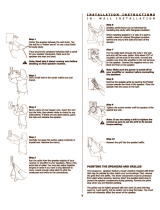
EXISTING CONSTRUCTION: INSTALLING A BRACKET
IMPORTANT: BEFORE YOU CUT INTO ANY WALL, REVIEW THE SECTIONS ON SPEAKER
PLACEMENT ON PAGE 6 AND RUNNING THE SPEAKER WIRE IN NEW CONSTRUCTION ON
PAGE 9. BE SURE NOT TO DRILL OR CUT THROUGH EXISTING WIRES, PIPES, OR STRUCTURE.
IF YOU FEEL ANY EXTRA RESISTANCE AS YOU ARE DRILLING OR SAWING, STOP!
1. Locate studs or joists by using a stud sensor or by hand knocking. Do not place the
edge of the cutout directly next to a stud or joist, since the frame and bracket will
extend beyond the cutout.
2.
At the planned cutout site, drill a 1/8-inch pilot hole just barely through the wall, about
an inch below the center of your proposed speaker location.
NOTE: IN MOST HOMES, THE WALL THICKNESS IS 1/2 TO 5/8 INCH.
3. Cut a foot-long piece of coat hanger and bend it to create a right angle. Poke the
“L-shaped” wire into the pilot hole and turn it in a
complete circle, as shown in Figure 12
.
4.
Continue turning the coat hanger as you move it
into the cavity to a depth of approximately
4 inches. If you feel an obstruction, fill the hole(s)
with spackling compound and repeat steps
1 through 4 at a new location.
5.
If the coat hanger moves freely in a complete circle,
hold the supplied template up to the wall or ceiling
and level it in the horizontal or vertical position. Use
a pencil to outline the cutout on the surface and
then drill the four corner holes with a 1/4-inch bit
(see Figure 13 on page 17).
6.
If you are cutting drywall, use a sheetrock or keyhole saw. Cut the outline with the saw
at a 45-degree angle. That way, the drywall section can be replaced cleanly if there is
an unseen obstruction behind the wall.
7.
If you are cutting into a plaster ceiling, use masking tape to outline the penciled open-
ing and use a razor to score the plaster down to the lath beneath. Then use a chisel to
remove all of the plaster within the taped outline. To actually cut the lath, consider the
following two professional methods:
• Use a saber saw with a metal cutting blade for the quickest cut. However, sawing
lath with a saber saw can easily vibrate plaster off the ceiling in a completely distant
location, thereby creating more patchwork.
• If you have the patience, use a pair of tin snips to slowly nip away at the lath instead.
There is little risk with this method – it is just more time consuming.
16
Figure 12. Using a coat
hanger to check for obstructions
behind the wall speaker site.





















